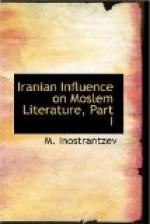[Footnote 1: The modern historian and Parsi scholar Karaka, in analysing the events subsequent to the Arab conquest follows the views of the old School of writers regarding this epoch as a complete destruction of all the previous organisation and the triumph of fanaticism of the new faith. See D.F. Karaka, History of the Parsis, Vol I; on the history of the Parsis subsequent to the Arab invasion see page 22 ff.]
[Footnote 2: E.B. Easrwick, Translation from the Persian of the “Kisseh-Sanjan” or “History of the arrival and settlement of the Parsis in India.” J.B.B.R.A.S., I. 1844, pp. 167-191. (See also Vol. 21, extra number, 1005, pp. 197-99).]
From the circumstances detailed in this book it appears that the emigrators after the establishment of Musalman domination passed a hundred years in a mountainous locality and only after the lapse of these long years migrated to Hormuz, from where they proceeded to the peninsula of Gujarat and finally after negotiations with the local chief settled in Sanjan. Subsequently fresh refugees joined them from Khorasan. From this last we can infer that the emigration was gradual and this is confirmed by the fact that in case of migration in a mass the diaspora of the Parsis would have left some traces in the Arabic literature. Further there is no doubt that considerable number of Parsis remained behind in their country and their descendants are the modern Persian Guebres who, together with the Parsis of India, may be called the only preservers of ancient Iranian tradition to the present times.
Thus, throughout Persia in the first centuries of Islam national elements with, changed fortunes persisted in their existence. It is, however, to be remarked that their success was not uniform in, every quarter of the country, that their fate depended to a considerable extent upon the geographical position and the historical life of the various provinces of the land. Western provinces owing to their proximity to the centre of the Arab ruling life had more than the rest to mingle with, the Arab stream, and to participate in the cycle of events in the Arabic period of the history of the Musalman East. Central Persia, owing to its geographical position, could not constitute the point d’appue of the Persian element. For the latter the most favourably situated provinces were those in the North, East, and South, Tabaristan, Khorasan, and Fars.
TABARISTAN.
As is well-known throughout the floruit of the Arab empire this province found itself in almost entire independence of the central power. Local dynasts called the Ispahbeds enjoyed practical independence and in those times Arabo-Moslem influences simply did not exist. Local rulers,—Bavendids, Baduspans, Karenides—appeared successively or simultaneously following the traditions left to them by the Marzbans or the land holders and partly




